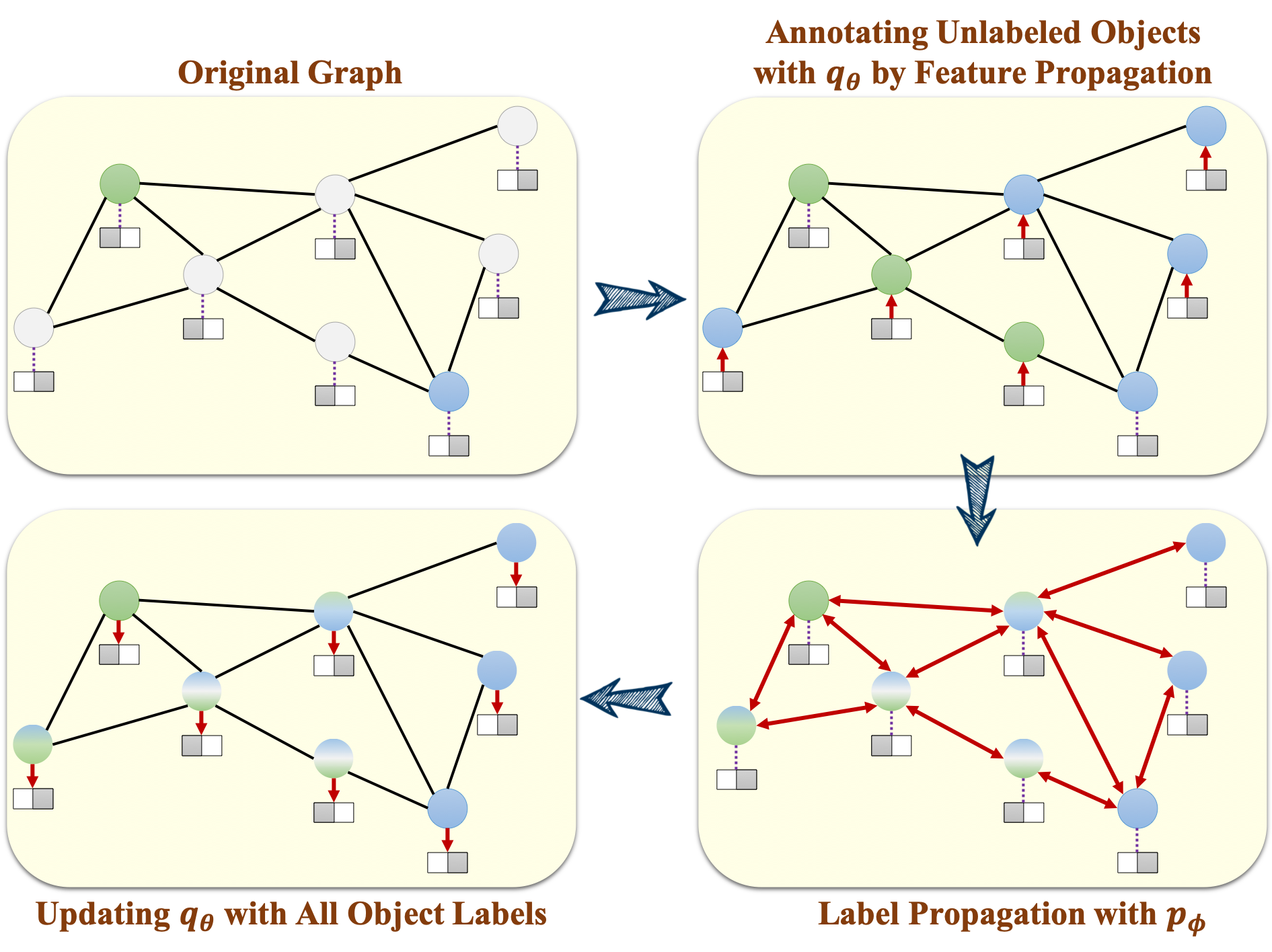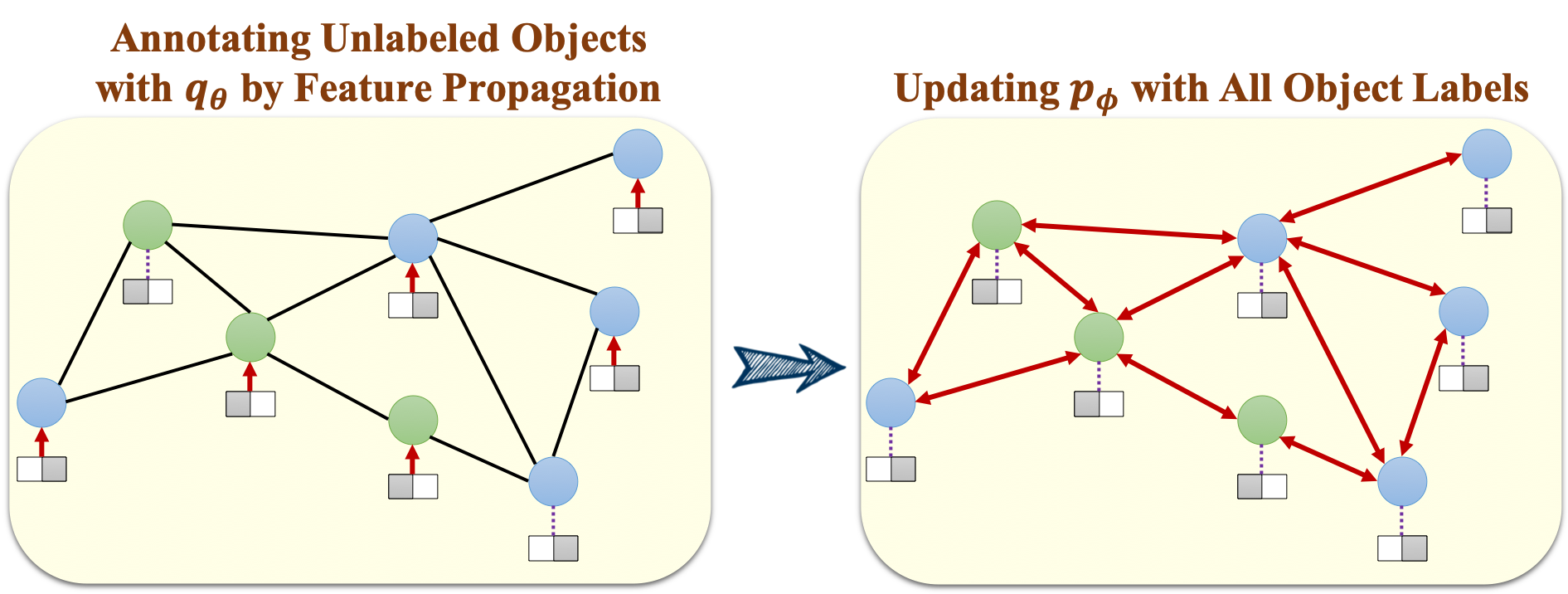This is an implementation of the GMNN (Graph Markov Neural Networks) model.
GMNN integrates statistical relational learning methods (e.g., relational Markov networks and Markov logic networks) and graph neural networks (e.g., graph convolutional networks and graph attention networks) for semi-supervised object classification. GMNN uses a conditional random field to define the joint distribution of all the object labels conditioned on object features, and the framework can be optimized with a pseudolikelihood variational EM algorithm, which alternates between an E-step and M-step. In the E-step, we infer the labels of unlabeled objects, and in the M-step, we learn the parameters to maximize the pseudolikelihood.
To benefit training such a model, we introduce two graph neural networks in GMNN, i.e., GNNp and GNNq. GNNq is used to improve inference by learning effective object representations through feature propagation. GNNp is used to model local label dependency through local label propagation. The variational EM algorithm for optimizing GMNN is similar to the co-training framework. In the E-step, GNNp annotates unlabeled objects for updating GNNq, and in the M-step, GNNq annotates unlabeled objects for optimizing GNNp.
GMNN can also be applied to many other applications, such as unsupervised node representation learning and link classification. In this repo, we provide codes for both semi-supervised object classification and unsupervised node representation learning.
We focus on the problem of semi-supervised object classification. Given some labeled objects in a graph, we aim at classifying the unlabeled objects.
GMNN uses two graph neural networks, one for learning object representations through feature propagation to improve inference, and the other one for modeling local label dependency through label propagation.
Both GNNs are optimized with the variational EM algorithm, which is similar to the co-training framework.
For semi-supervised object classification, we provide the Cora, Citeseer and Pubmed datasets. For unsupervised node representation learning, we provide the Cora and Citeseer datasets. The datasets are constructed by Yang et al., 2016, and we preprocess the datasets into our format by using the codes from Thomas N. Kipf. Users can also use their own datasets by following the format of the provided datasets.
The codes for semi-supervised object classification can be found in the folder semisupervised. The implementation corresponds to the variant GMNN W/o Attr. in p in the Table 2 of the original paper. To run the codes, go to the folder semisupervised/codes and execute python run_cora.py. Then the program will print the results over 100 runs with seeds 1~100.
The mean accuracy and standard deviation are summarized in the following tables:
| Dataset | Cora | Citeseer | Pubmed |
|---|---|---|---|
| GMNN | 83.4 (0.8) | 73.0 (0.8) | 81.3 (0.5) |
The codes for unsupervised node representation learning are in the folder unsupervised. The implementation corresponds to the variant GMNN With q and p in the Table 3 of the original paper. To run the codes, go to the folder unsupervised/codes and execute python run_cora.py. Then the program will print the results over 50 runs.
The mean accuracy and standard deviation are summarized in the following tables:
| Dataset | Cora | Citeseer |
|---|---|---|
| GMNN | 82.6 (0.5) | 71.4 (0.5) |
Note that the numbers are slightly different from those in the paper, since we make some changes to the codes before release.
Some codes of the project are from the following repo: pygcn.
Please cite the following paper if you use the codes of GMNN. Thank you!
@inproceedings{qu2019gmnn,
title={GMNN: Graph Markov Neural Networks},
author={Qu, Meng and Bengio, Yoshua and Tang, Jian},
booktitle={International Conference on Machine Learning},
pages={5241--5250},
year={2019}
}



